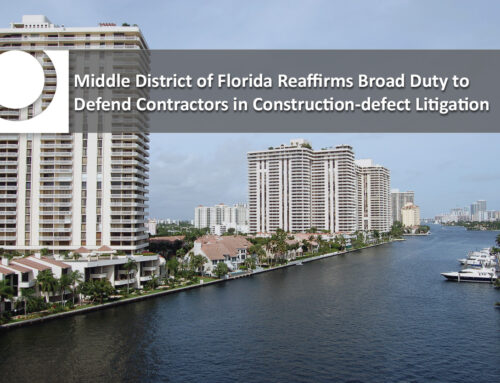Last week, the Florida Supreme Court put policyholders’ minds at ease in Sebo v. American Home Assurance Co. by overturning a lower appellate court’s decision holding that the concurrent cause doctrine had no place in Florida first-party property claims.
 Until the appellate court’s decision in 2013, Florida courts had routinely applied the concurrent cause doctrine in deciding whether a loss caused by two or more independent perils was covered under a property insurance policy. But that was turned on its head when the appellate court found the concurrent cause doctrine had no place in first-party insurance claims — regardless of whether the causes of loss were dependent or independent. Instead, the appellate court held the efficient proximate cause doctrine applied and remanded the case for a determination of the efficient cause of the loss.
Until the appellate court’s decision in 2013, Florida courts had routinely applied the concurrent cause doctrine in deciding whether a loss caused by two or more independent perils was covered under a property insurance policy. But that was turned on its head when the appellate court found the concurrent cause doctrine had no place in first-party insurance claims — regardless of whether the causes of loss were dependent or independent. Instead, the appellate court held the efficient proximate cause doctrine applied and remanded the case for a determination of the efficient cause of the loss.
So what are the concurrent cause and efficient proximate cause doctrines? How do these doctrines affect policyholders?
The efficient proximate cause doctrine provides that where two or more perils combine to cause the loss, only the efficient cause — the one that set the others in motion — is the cause to which the loss is attributed for determining insurance coverage. Under this rule, when a covered peril sets into motion an uncovered peril, the entire loss is covered. But when an uncovered peril sets into motion a covered peril, the entire loss is not covered.
For example, suppose that a policy does not cover a loss caused by an explosion, but a loss caused by a fire is covered. Under the efficient proximate cause doctrine, if an explosion causes a fire, the entire loss is not covered. But if a fire causes an explosion, the entire loss is covered. Simple. But what if the causes are independent?
That’s where the concurrent cause doctrine comes in play. This doctrine provides that where two or more independent perils combine to cause the loss, as long as one of the perils is covered, the entire claim is covered.
In Sebo, the Florida Supreme Court noted that there was no dispute that rainwater, hurricane winds, and construction defects had all combined to cause the insured’s loss (which is all too common in Florida). Because there was “no reasonable way” to distinguish the efficient cause of the loss, the Court found the efficient proximate cause doctrine could not apply. Instead, the concurrent cause doctrine applied and, because one of the causes was a covered peril, the entire claim was covered.
How does this ruling affect policyholders?
If the loss was caused by two or more independent perils, then policyholders don’t have to prove there was a proximate cause or that the proximate cause is a covered peril. Instead, a policyholder need only prove that one of the causes is a covered peril.
Does this mean all first-party property claims are covered?
No. Although Sebo is good news for policyholders, the Court left the door open for the application of the efficient proximate cause doctrine in other circumstances. The Court’s ruling limited the application of the concurrent cause doctrine to claims where the causes were independent and a proximate cause of the loss could not be determined. Thus, where the proximate cause can be determined and the proximate cause is an excluded peril, insurers will continue to argue the application of the efficient proximate cause doctrine and take the position that the loss is not covered.
Conclusion
Sebo is a win for policyholders. All too often insurers look for ways to deny claims and the appellate court’s opinion had provided another basis for doing just that. Further, we are often approached by condominium associations and individual homeowners seeking representation for property damage claims relating to construction defects, but sometimes it is too late to bring those claims against the culpable parties like the developers and contractors. Sebo provides relief to those insureds and allows for another avenue for recovery under their property insurance policies.



